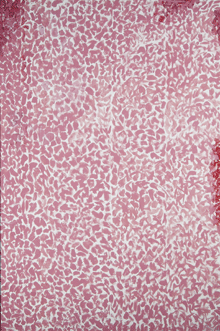
'DOUBLE CHERRY BLOSSOMS' Acrylic on canvas,
60 by 40 inches, 1973, by Alma Woodsey Thomas |
When art and nature are mentioned together, most people tend to envision landscapes, especially in Maine. A smart show at the Bowdoin College Museum of Art reminds us that nature is more than green stuff.
“Regarding the Forces of Nature: From Alma Thomas to Yayoi Kusama” occupies just two galleries and assembles mostly works on paper from the museum’s permanent collection, augmented with loans and promised gifts. Other artists included besides Thomas and Kusama are Polly Apfelbaum, Jo Baer, Jill Baroff, Christine Hiebert, Sylvia Plimack Mangold, Edda Renouf, Dorothea Rockburne, Alyson Shotz, and Pat Steir. I have to confess wariness over the women-artists-only selection, but curator Joachim Homann explained that the intent was to create a Western counterpoint to the recently closed exhibition of contemporary Chinese women artists.
Most works are on paper and were executed between the 1970s and 1990s. While that may seem to date them, they have actually remained utterly fresh not least because they address timeless subjects and make a strong point for the investigative nature of art, created at a point when conceptual art intersected with perception- and process-oriented art. The trope of artist-as-scientist of course goes back to the Renaissance, and these contemporary practitioners likewise investigate and harness forces of a material and immaterial nature.
Magnetism, that invisible but pervasive power, makes for a forceful collaborator in Shotz’s reflective stainless steel cube — the only sculpture in the show — which sprouts beautiful mounds of little, shiny balls. The tension between the elegance of the piece’s presentation and the intimation of cellular growth and primal force is perfectly pitched.
Renouf digs deep into thick sheets of paper (and linen for her paintings) to reveal their structure. Forcefully incising lines and dislodging material, the artist covers the violated areas with vibrant and sensual oils and pastels that reflect elemental forces, including water and earth. Surface and subterranean matter, positive and negative, coexist to stunning effect.
Not all work represents the artists at their best. Steir’s small drip paintings are a far cry from her diaphanous veils of color, and Apfelbaum’s silkscreens “Color Exercises” are overwhelmingly didactic. In contrast, although uncharacteristic of Rockburne’s best-known, tightly formal work, her untitled monoprint from 1992-1994 does combine her study of mathematical and geometrical principles with gestural process. Layer after layer of meandering lines superimposed over an abstract framework turn prolonged viewing into an intriguing visual journey.
For me, Baer’s nine-part silkscreen series, “Cardinations” (1974), is the most understated yet most conceptually exciting piece. Stylized numerals 1–9 are inscribed within circles that, on closer inspection, reveal lines of color that veer between reinforcing the overall design or abandoning all compliance and going off on tangents. This richly envisioned potential of a minimalist vocabulary is immensely satisfying to comprehend.
Thomas’s “Double Cherry Blossoms” of 1973 is full of flickering light and color captured in staccato brushstrokes that take pointillism to its rhythmic, abstract extreme, while remaining based on observation of the world. In contrast, Kusama seems to be after optical effect alone and also to have taken a lesson from Australian Aboriginal painters albeit without the spiritual and territorial significance of their works. In Kusama’s “White Nets” of 2007, pulsating fields of feathery white-on-black brushstrokes alternately cluster and disperse to shimmering effect.